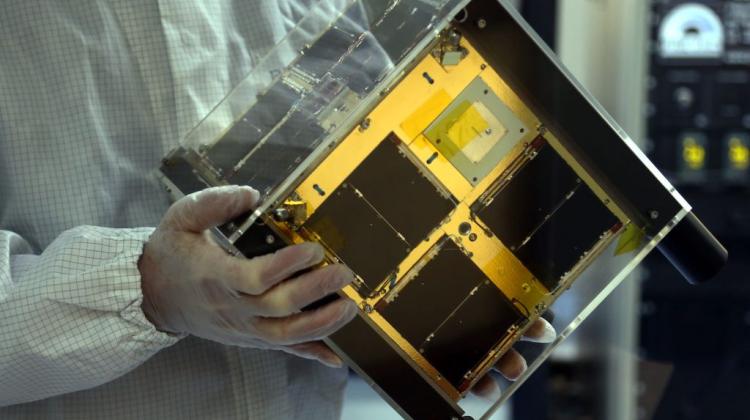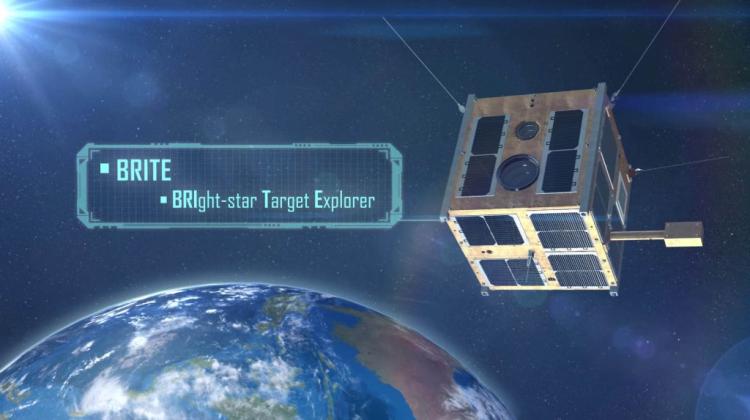Contact with the Polish satellite Hevelius established

Contact has been established with the Polish satellite Hevelius carried into Earth orbit last week on Tuesday by a rocket launched from China. Hevelius joined its twin device Lem, which orbits the Earth since November 2013.
The first attempt to communicate with Polish satellite was made few minutes past 10 AM at the Nicolaus Copernicus Astronomical Center PAS, which has a set of antennas and other devices allowing to establish contact.
Transmission of this attempt could be viewed in Gdańsk Hewelianum Centre, where last week on Tuesday organisers scheduled a number of events related to satellite launch into orbit. "Just like the rocket launch, the attempt to establish communication was successful" - Dr. Piotr Orleański from the Space Research Centre PAS told reporters at the Gdańsk Centre.
The scientist added that Hevelius, just like the four other devices of this type, which are already orbiting the Earth, will provide scientists with data on with the 286 brightest stars. "It will measure changes in the brightness of stars, and thus allow scientists to peek inside them. On the basis of changes in brightness we are able to determine what kind of thermonuclear and other reactions take place inside the star, and this in turn gives us the knowledge on the structure of individual stars" - Orleański told reporters.
The scientist explained that for the next few, maybe several weeks, scientists will try to connect with Hevelius every day to calibrate it and run all its subsystems. When this is completed, the satellite will begin its proper operation, namely the collection and transmission of data from observations of the stars.
Orleański said that Hevelius revolves around the Earth at a speed of about 28,000 km/h, so it has a period of about 90 minutes. He added that on some days communication with the device from Poland can be established up to 3-4 times per day. "There will, however, be days when this will not possible at all" - he said.
According to Orleański placing the second Polish satellite in orbit could be an incentive for the development of Polish space research program. He noted that it would not be a comprehensive program with a scale comparable, for example, with NASA, but less expensive, but very useful projects related to satellites and satellite observation.
Senator Edmund Wittbrodt, who attended the event at Hewelianum, reminded that the Polish Space Agency would be launched next year. He added that the Senate recently adopted amendments to the Act to increase the Agency’s competence and move the Agency\'s headquarters to Gdańsk. In August, the Sejm will address the changes in the law.
Hevelius was carried into space by rocket Long March 4B, launched on Tuesday morning from the Taiyuan Satellite Launch Center in China. The takeoff took place at approx. 5:15 CET. Fourteen minutes later, the rocket reached the desired altitude and a special ejector released the satellite, placing it in orbit.
Orleański revealed that the Chinese charged USD 30 thousand per kilogram launched. He added that it was more or less a standard fee, and the satellite along with ejector weighed approx. 15 kg.
Hevelius is one of six satellites were built for the Austro-Canadian-Polish project Brite. Five devices, including Polish Lem, were placed in space before: unfortunately, one of the satellites was lost, its fate is unknown. All devices share similar design - they weigh less than 7 kg, and have the shape of a cube with a side of approx. 20 cm. They will carry out precise measurements of 286 brightest stars.
Brite-type satellites were developed in cooperation with the University of Vienna, Graz University of Technology, the University of Toronto and the University of Montreal. Polish Hevelius and Lem were built by specialists from the Space Research Centre PAS for and the Nicolaus Copernicus Astronomical Center PAS in Warsaw. Ministry of Science and Higher Education allocated PLN 14.2 million to their construction.
PAP - Science and Scholarship in Poland
aks/ mki/ woj/ mrt/
tr. RL
Przed dodaniem komentarza prosimy o zapoznanie z Regulaminem forum serwisu Nauka w Polsce.


















